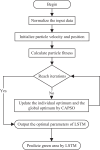A cosine adaptive particle swarm optimization based long-short term memory method for urban green area prediction
- PMID: 38855216
- PMCID: PMC11157564
- DOI: 10.7717/peerj-cs.2048
A cosine adaptive particle swarm optimization based long-short term memory method for urban green area prediction
Abstract
In the quest for sustainable urban development, precise quantification of urban green space is paramount. This research delineates the implementation of a Cosine Adaptive Particle Swarm Optimization Long Short-Term Memory (CAPSO-LSTM) model, utilizing a comprehensive dataset from Beijing (1998-2021) to train and test the model. The CAPSO-LSTM model, which integrates a cosine adaptive mechanism into particle swarm optimization, advances the optimization of long short-term memory (LSTM) network hyperparameters. Comparative analyses are conducted against conventional LSTM and Partical Swarm Optimization (PSO)-LSTM frameworks, employing mean absolute error (MAE), root mean square error (RMSE), and mean absolute percentage error (MAPE) as evaluative benchmarks. The findings indicate that the CAPSO-LSTM model exhibits a substantial improvement in prediction accuracy over the LSTM model, manifesting as a 66.33% decrease in MAE, a 73.78% decrease in RMSE, and a 57.14% decrease in MAPE. Similarly, when compared to the PSO-LSTM model, the CAPSO-LSTM model demonstrates a 58.36% decrease in MAE, a 65.39% decrease in RMSE, and a 50% decrease in MAPE. These results underscore the efficacy of the CAPSO-LSTM model in enhancing urban green space area prediction, suggesting its significant potential for aiding urban planning and environmental policy formulation.
Keywords: Cosine adaptive; Long series prediction; Long-short term memory; Particle swarm optimization; Urban green area.
© 2024 Tian et al.
Conflict of interest statement
The authors declare that they have no competing interests. Ke Yan is employed by Construction Third Engineering Bureau Installation Engineering Co., Ltd.
Figures





Similar articles
-
CEEMDAN-IPSO-LSTM: A Novel Model for Short-Term Passenger Flow Prediction in Urban Rail Transit Systems.Int J Environ Res Public Health. 2022 Dec 7;19(24):16433. doi: 10.3390/ijerph192416433. Int J Environ Res Public Health. 2022. PMID: 36554314 Free PMC article.
-
An adaptive particle swarm optimization-based hybrid long short-term memory model for stock price time series forecasting.Soft comput. 2022;26(22):12115-12135. doi: 10.1007/s00500-022-07451-8. Epub 2022 Aug 26. Soft comput. 2022. PMID: 36043118 Free PMC article.
-
A deep learning-based hybrid method for PM2.5 prediction in central and western China.Sci Rep. 2025 Mar 24;15(1):10080. doi: 10.1038/s41598-025-95460-6. Sci Rep. 2025. PMID: 40128263 Free PMC article.
-
A Hybrid Soft Sensor Model for Measuring the Oxygen Content in Boiler Flue Gas.Sensors (Basel). 2024 Apr 7;24(7):2340. doi: 10.3390/s24072340. Sensors (Basel). 2024. PMID: 38610551 Free PMC article.
-
Time series forecasting of new cases and new deaths rate for COVID-19 using deep learning methods.Results Phys. 2021 Aug;27:104495. doi: 10.1016/j.rinp.2021.104495. Epub 2021 Jun 26. Results Phys. 2021. PMID: 34221854 Free PMC article.
References
-
- Aly D, Dimitrijevic B. Public green space quantity and distribution in Cairo, Egypt. Journal of Engineering and Applied Science. 2022;69(1):221. doi: 10.1186/s44147-021-00067-z. - DOI
-
- Aranha C, Villalón CLC, Campelo F, Dorigo M, Ruiz R, Sevaux M, Sörensen K, Stützle T. Metaphor-based metaheuristics, a call for action: the elephant in the room. Swarm Intelligence. 2022;16(1):1–6. doi: 10.1007/s11721-021-00202-9. - DOI
-
- Basu S, Nagendra H. Perceptions of park visitors on access to urban parks and benefits of green spaces. Urban Forestry and Urban Greening. 2021;57(52):126959. doi: 10.1016/j.ufug.2020.126959. - DOI
-
- Bharti, Redhu P, Kumar K. Short-term traffic flow prediction based on optimized deep learning neural network: PSO-BI-LSTM. Physica A: Statistical Mechanics and its Applications. 2023;625(22):129001. doi: 10.1016/j.physa.2023.129001. - DOI
-
- Das DK. Factors and strategies for environmental justice in organized urban green space development. Urban Planning. 2022;7(2):160–173. doi: 10.17645/up.v7i2.5010. - DOI
LinkOut - more resources
Full Text Sources
